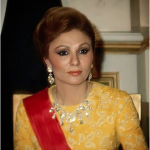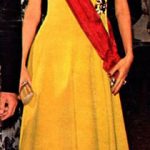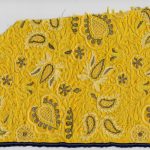



Strange destiny of Keyvan Khosrovani a liberal minded intellectual artist accepting a king only in chess set and admiring the honeybee queen to design for an empress. His vocation dominated his personal convictions and focused on innovating five Iranian major crafts Batik, Ghalamkar, Esfahan’s embroideries as well as Baluchestan’s and finally Brocade for thirteen years of unpaid effort while his name was under censorship by the last empress via her cabinet.
Batik to be used in haute couture demanded a special reinforcing procedure while using it for tailleurs, gowns, hats, shoes, and purses. In Oskoo’s workshops the fabric design was possible only during limited period of the year with mild temperature in order to keep the wax liquid. Here are some images of his collection of Batik. Keyvan’s most important innovation was his achievement to stamp on thick woollen crepe for the first time a Batik fabric to be used for an over coat. He used the same colour and pattern silk Batik for the lining and the dress as an ensemble shown here worn in Paris during a lunch at Elysees Palace. The magnificent Batik gown worn during a soirée at Kennedy Centre Opera in Washington DC now kept in Galliera museum in Paris should be mentioned.
Ghalamkar of Esfahan was and is a dying art in Iran compared with its origin or the same craft in Rajestan-India. What Keyvan managed as in other fields of his achievements in innovating Iranian crafts was to simplify this Ghalamkar by using new colours and fabrics never used before.
Souzandouzi [embroidery] of Esfahan also received another innovation by mixing Ghalmkar prints as the basic pattern of this embroidery, again a technique never done before. Here one can admire some of Keyvan’s creations with his innovated craft yet keeping the tradition intact.
Baluchestan embroideries remain predominant art in his creations and here images show the result an excellent teamwork of hard and creative project. Keyvan’s first gown with turquoise embroidery is now part of the permanent collection of Galliera museum of Paris.
Brocade is a sublime part of Keyvan’s royal collection as the golden gown worn for the inauguration of Persepolis festivities that he calls it the beginning of the end. The design of this gown and a silver-white brocade version is an architecture inspired by Esfahan’s domes and haute couture. In this project collaboration with Oustad Tarighi remains a historic one in the art of brocade. All motives chosen by Keyvan diminish in size in the weave of fabric hens reaching the shoulders the floral design is complete. Each panel has its unique pattern like the front of the gown, short sleeves, lower floral patterns of the over gown. Motives when reaching one another not only the floral patterns are complete but also the gowns fit beautifully the last empress Farah Pahlavi with a great allure. Each version took 18 months to be woven at their best. Unfortunately now the major part of Keyvan’s creations is kept very poorly in the basement of Niavaran palace waiting their total deterioration.